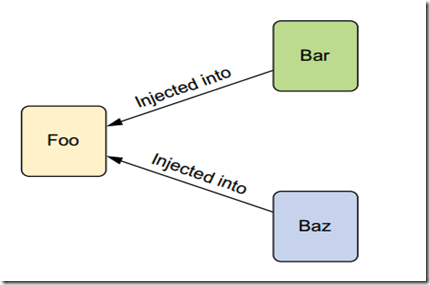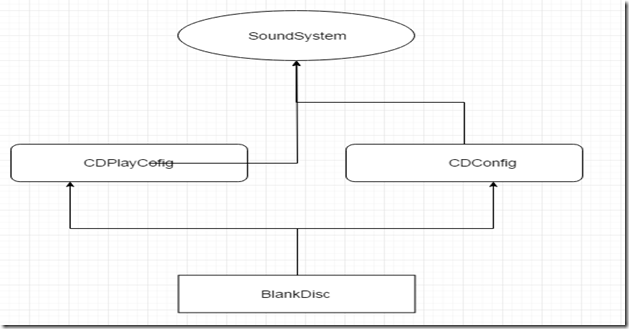本文代码部分来自于《spring in action》,本文讲的是使用!!
Spring 是为了解决什么
一个框架的存在是为了解决某个问题的,那么Spring这个框架是为了解决什么问题呢?主要就是解耦,spring主要要把握两方面的知识,
- DI(依赖注入 dependency injection) : 解耦, 方便测试
- AOP(面向切面编程 aspect-oriented programming)
关于 DI Ioc 和 AOP 可以先阅读这篇文章,本文讲的主要是使用。
DI (依赖注入 depency injection)
先看一个例子:
1 //定义一个勇士类 2 public class DamselRescuingKnight implements Knight { 3 4 private RescueDamselQuest quest; 5 6 //营救任务 7 public DamselRescuingKnight() { 8 this.quest = new RescueDamselQuest(); 9 } 10 11 public void embarkOnQuest() { 12 quest.embark(); 13 } 14 }
可以看到这里,勇士的 embarkOnQuest ( ) 方法执行的传入的特定的任务,那么当勇士需要执行其他任务的时候就无法进行了,于是Queue 应该做成一个接口.这样的好处是解耦合和方便测试
1 public class BraveKnight implements Knight { 2 private Quest quest; 3 4 public BraveKnight(Quest quest) { 5 this.quest = quest; 6 } 7 8 public void embarkOnQuest() { 9 quest.embark(); 10 } 11 }
1 public class SlayDragonQuest implements Quest { 2 private PrintStream stream; 3 4 public SlayDragonQuest(PrintStream stream) { 5 this.stream = stream; 6 } 7 8 public void embark() { 9 stream.println("Embarking on quest to slay the dragon!"); 10 } 11 }上面使用依赖注入并且在构造器解耦被称为构造器解耦。 在spring中如何组装这些组件呢?(将queue配置给knight)
1 <?xml version="1.0" encoding="UTF-8"?> 2 <beans xmlns="http://www.springframework.org/schema/beans" 3 xmlns:xsi="http://www.w3.org/2001/XMLSchema-instance" 4 xsi:schemaLocation="http://www.springframework.org/schema/beans 5 http://www.springframework.org/schema/beans/spring-beans.xsd"> 6 7 <bean id="knight" class="com.springinaction.knights.BraveKnight"> 8 <constructor-arg ref="quest" /> 9 </bean> 10 11 <bean id="quest" class="com.springinaction.knights.SlayDragonQuest"> 12 <constructor-arg value="#{T(System).out}" /> 13 </bean> 14 </beans>
图一. 依赖注入会将所依赖的关系自动交给目标对象, 而不是让对象自己去获取依赖
AOP(面向切面编程)
加入一个勇士需要一个历史记录着纪录它的英雄事迹,那么
1 public class Recorder { 2 private PrintStream stream; 3 4 public Recorder(PrintStream stream) { 5 this.stream = stream; 6 } 7 8 public void singBeforeQuest() { 9 stream.println("Fa la la, the knight is so brave!"); 10 } 11 12 public void singAfterQuest() { 13 stream.println("Tee hee hee, the brave knight " + 14 "did embark on a quest!"); 15 } 16 }
1 public class BraveKnight implements Knight { 2 private Quest quest; 3 private Recorder recorder; 4 5 public BraveKnight(Quest quest, Recorder recorder) { 6 this.quest = quest; 7 this.recorder= recorder; 8 } 9 10 public void embarkOnQuest() throws QuestException { 11 recorder.singBeforeQuest(); 12 quest.embark(); 13 recorder.singAfterQuest(); 14 } 15 }
但是这样似乎有点不合常理,当我需要一名勇士时是否每次都要匹配以为记录者?假如记录着可以当我需要的时候出现那么就好了。使用spring的AOP 编程,
1 <?xml version="1.0" encoding="UTF-8"?> 2 <beans xmlns="http://www.springframework.org/schema/beans" 3 xmlns:xsi="http://www.w3.org/2001/XMLSchema-instance" 4 xmlns:aop="http://www.springframework.org/schema/aop" 5 xsi:schemaLocation="http://www.springframework.org/schema/aop 6 http://www.springframework.org/schema/aop/spring-aop-3.2.xsd 7 http://www.springframework.org/schema/beans 8 http://www.springframework.org/schema/beans/spring-beans.xsd"> 9 10 <bean id="knight" class="com.springinaction.knights.BraveKnight"> 11 <constructor-arg ref="quest"/> 12 </bean> 13 14 <bean id="quest" class="com.springinaction.knights.SlayDragonQuest"> 15 <constructor-arg value="#{T(System).out}"/> 16 </bean> 17 18 <bean id="minstrel" class="com.springinaction.knights.Recorder"> 19 <constructor-arg value="#{T(System).out}"/> 20 </bean> 21 22 <aop:config> 23 <aop:aspect ref="recorder"> 24 <aop:pointcut id="embark" 25 expression="execution(* *.embarkOnQuest(..))"/> 26 <aop:before pointcut-ref="embark" 27 method="singBeforeQuest"/> 28 <aop:after pointcut-ref="embark" 29 method="singAfterQuest"/> 30 </aop:aspect> 31 </aop:config> 32 </beans> 33
Spring 容器
spring容器是使用DI(依赖注入)去管理组成应用的组件,其中包括两大类,
- Application Cotext
- Bean Factories
Bean Factories 主要是低水准的应用, 下面主要介绍application context,它包括
- AnnotationConfigApplicationContext :从一个或多个java形式的class文件中加载一个spring 应用
- AnnotationConfigWebApplicationContext : 从一个或多个java形式的class文件中加载一个spring web应用
- FileSystemXmlApplication : 加载一个上下文定义(context)从文件路径中的xml文件
- XmlWebApplicationConte
- ClassPathXmlApplication
AnnotationConfigWebApplicationContext 和 XmlWebApplicationContext 我们使用比较多的
装配组件
三种方式
- XML 形式
- JavaConfig形式
- 隐式的bean发现机制 和 自动装配
三种方式的选择: 根据《spring in action》的描述,隐式的bean 发现和自动装配方式强与显式装配, 假若不得不显式装配,优先选择类型安全的java编码形式的,最后才是XML形式 。
自动配置
Spring从两个角度来实现自动化装配:(一个是生成独立的bean, 一个是将他们组装起来)
- 组件扫描(component scanning) : Spring会自动发现应用上下文中所创建的bean。
- 自动装配(autowiring) : Spring自动满足bean之间的依赖。
@Component 属性表明这个类是个组件,并且告诉spring 因为为它创建一个been
1 @Component 2 public class SgtPeppers implements CompactDisc { 3 private String title = "Sgt. Pepper's Lonely Hearts Club Band"; 4 private String artist = "The Beatles"; 5 6 public void play() { 7 System.out.println("Playing " + title + " by " + artist); 8 } 9 }
1 @Configuration 2 @ComponentScan 3 public class CDPlayerConfig { 4 5 }
@ComponentScan 表示组件扫描,在这个包下的组件都会被扫描出来并且创建为been,而@Configuration 将会在下面讲到,同时上面也可以通过xml的形式创建
1 <?xml version="1.0" encoding="UTF-8"?> 2 <beans xmlns="http://www.springframework.org/schema/beans" 3 xmlns:xsi="http://www.w3.org/2001/XMLSchema-instance" 4 xmlns:context="http://www.springframework.org/schema/context" 5 xsi:schemaLocation="http://www.springframework.org/schema/beans 6 http://www.springframework.org/schema/beans/spring-beans.xsd 7 http://www.springframework.org/schema/context 8 http://www.springframework.org/schema/context/spring-context.xsd"> 9 <context:component-scan base-package="soundsystem" /> 10 </beans>
组件被scan 后会生成一个bean ,然后生成一个id,默认为类名,那么下面展示的如何自定义这个id的名字,和如何指定spring在特定的路径下进行扫描
1 1 //组件命名 2 2 @Component("lonelyHeartsClub") 3 3 public class SgtPeppers implements CompactDisc { 4 4 ... 5 5 } 6 6 7 7 //扫描基本路径,多个基本路径 8 8 @Configuration 9 9 @ComponentScan(basePackages= {"soundsystem", "video"}) 10 10 public class CDPlayerConfig {}
扫描基类下的所有类
1 @Configuration 2 @ComponentScan(basePackageClasses={CDPlayer.class, DVDPlayer.class}) 3 public class CDPlayerConfig {}
扫描完了,下面展示如何自动装配,使用@Autowired 注解,spring会自动将bean 加载进来,但是当bean 不存在时,spring加载时会抛出错误,为了防止spring直接抛出错误,可以设置 required = false
1 @Component 2 public class CDPlayer implements MediaPlayer { 3 private CompactDisc cd; 4 @Autowired 5 public CDPlayer(CompactDisc cd) { 6 this.cd = cd; 7 } 8 public void play() { 9 cd.play(); 10 } 11 12 @Autowired(required=false) 13 public OtherCDPlayer(CompactDisc cd) { 14 this.cd = cd; 15 } 16 }
JAVA 编码装配bean
当我们需要使用到第三方库时,我们就不能使用自动装配机制,可以使用XML形式和JavaConfig的形式来进行显式装配,java编码比xml形式的重构更加友好,类型安全,更加强大。
1 @Configuration 2 public class CDPlayerConfig { 3 }
使用@Configuration 注解表明这个类通过javaConfig形式告知spring为它创建一个bean。另外加入我们调用一个方法,而方法返回值是个对象,我们希望这个对象被spring生成一个bean,这又怎么写呢?
1 @Bean(name="lonelyHeartsClubBand") 2 public CompactDisc sgtPeppers() { 3 return new SgtPeppers(); 4 }
和上面自动扫描一样,我们创建了bean, 是时候把它们装配起来了,假如CDPlayer 这个对象依赖CompactDisc 这个对象,我们需要对它进行注入。上面的代码可以知道sgtPeppers( ) 方法可以获取一个bean对象。
1 @Bean 2 public CDPlayer cdPlayer() { 3 return new CDPlayer(sgtPeppers()); 4 }
可以看到我们同样调用了sgtPeppers( ) 方法,使用了@Bean注解,这个需要注意的是spring创建的bean都会是单例,什么意思呢?
1 @Bean 2 public CDPlayer cdPlayer() { 3 return new CDPlayer(sgtPeppers()); 4 } 5 @Bean 6 public CDPlayer anotherCDPlayer() { 7 return new CDPlayer(sgtPeppers()); 8 }
在sgtPeppers( )方法中即使我们使用new 一个新的对象,调用这两个方法返回的CDPlay( )却是相同的,都是spring 创建的bean对象。我们可以使用一个简单的方式写法。
1 @Bean 2 public CDPlayer cdPlayer(CompactDisc compactDisc) { 3 return new CDPlayer(compactDisc); 4 }
XML 方式装配bean
使用XML 形式进行装配bean,
1 <?xml version="1.0" encoding="UTF-8"?> 2 <beans xmlns="http://www.springframework.org/schema/beans" 3 xmlns:xsi="http://www.w3.org/2001/XMLSchema-instance" 4 xsi:schemaLocation="http://www.springframework.org/schema/beans 5 http://www.springframework.org/schema/beans/spring-beans.xsd 6 http://www.springframework.org/schema/context"> 7 8 <bean id="cdPlay" class="soundsystem.SgtPeppers"> 9 </beans>
初始化bean构造器注入有两种方式
- 使用<constructor-arg>
- 使用c-命名空间在Spring 3.0
下面使用的时第一种,ref是传入的引用,是某个bean 的id
1 <bean id="cdPlayer" class="soundsystem.CDPlayer"> 2 <constructor-arg ref="compactDisc" /> 3 </bean>
如果存在下面的类
1 public class BlankDisc implements CompactDisc { 2 private String title; 3 private String artist; 4 public BlankDisc(String title, String artist) { 5 this.title = title; 6 this.artist = artist; 7 } 8 public void play() { 9 System.out.println("Playing " + title + " by " + artist); 10 } 11 }
那么构造器依赖注入就是
1 <bean id="compactDisc" class="soundsystem.BlankDisc"> 2 <constructor-arg value="Sgt. Pepper's Lonely Hearts Club Band"/> 3 <constructor-arg value="The Beatles"/> 4 </bean> 5 6 <!--下面是c-命名空间,下划线后加参数名字--> 7 <bean id="compactDisc" 8 class="soundsystem.BlankDisc" 9 c:_title="Sgt. Pepper's Lonely Hearts Club Band" 10 c:_artist="The Beatles" /> 11 12 <!--也可以这样子写--> 13 <bean id="compactDisc" 14 class="soundsystem.BlankDisc" 15 c:_0="Sgt. Pepper's Lonely Hearts Club Band" 16 c:_1="The Beatles" /> 17
如果构造参数中有List,或是set,要是set 的话,只需要改节点为<set>
1 <bean id="compactDisc" class="soundsystem.BlankDisc"> 2 <constructor-arg value="Sgt. Pepper's Lonely Hearts Club Band" /> 3 <constructor-arg value="The Beatles" /> 4 <constructor-arg> 5 <list> 6 <value>Sgt. Pepper's Lonely Hearts Club Band</value> 7 <value>With a Little Help from My Friends</value> 8 <value>Lucy in the Sky with Diamonds</value> 9 <value>Getting Better</value> 10 <value>Fixing a Hole</value> 11 <!-- ...other tracks omitted for brevity... --> 12 </list> 13 </constructor-arg> 14 </bean>
如果使用c命名空间的构造器注入,必须向在开头声明命令空间
1 2 <?xml version="1.0" encoding="UTF-8"?> 3 <beans xmlns="http://www.springframework.org/schema/beans" 4 xmlns:c="http://www.springframework.org/schema/c" 5 xmlns:xsi="http://www.w3.org/2001/XMLSchema-instance" 6 xsi:schemaLocation="http://www.springframework.org/schema/beans 7 http://www.springframework.org/schema/beans/spring-beans.xsd"> 8 ... 9 </beans>
下面是如何使用
1 <bean id="cdPlayer" class="soundsystem.CDPlayer" 2 c:cd-ref="compactDisc" />
假如一个类没有构造方法,需要对属性进行注入
1 public class BlankDisc implements CompactDisc { 2 private String title; 3 private String artist; 4 private List<String> tracks; 5 public void setTitle(String title) { 6 this.title = title; 7 } 8 public void setArtist(String artist) { 9 this.artist = artist; 10 } 11 12 public void setTracks(List<String> tracks) { 13 this.tracks = tracks; 14 } 15 public void play() { 16 System.out.println("Playing " + title + " by " + artist); 17 for (String track : tracks) { 18 System.out.println("-Track: " + track); 19 } 20 } 21 }
1 <bean id="compactDisc" 2 class="soundsystem.BlankDisc"> 3 <property name="title" 4 value="Sgt. Pepper's Lonely Hearts Club Band" /> 5 <property name="artist" value="The Beatles" /> 6 <property name="tracks"> 7 <list> 8 <value>Sgt. Pepper's Lonely Hearts Club Band</value> 9 <value>With a Little Help from My Friends</value> 10 <value>Lucy in the Sky with Diamonds</value> 11 <value>Getting Better</value> 12 <value>Fixing a Hole</value> 13 <!-- ...other tracks omitted for brevity... --> 14 </list> 15 </property> 16 </bean> 17
和c-命名空间相同, p-命名空间用来标识属性注入的,但是需要注意的是p-命名空间不能注入List,只能用spring-util 命名空间对集合进行注入,同样,在使用命令空间时需要在xml开头声明
1 xmlns:p="http://www.springframework.org/schema/p" 2 xmlns:util="http://www.springframework.org/schema/util"
1 <bean id="compactDisc" 2 class="soundsystem.BlankDisc" 3 p:title="Sgt. Pepper's Lonely Hearts Club Band" 4 p:artist="The Beatles" 5 p:tracks-ref="trackList" />
1 <util:list id="trackList"> 2 <value>Sgt. Pepper's Lonely Hearts Club Band</value> 3 <value>With a Little Help from My Friends</value> 4 <value>Lucy in the Sky with Diamonds</value> 5 <value>Getting Better</value> 6 <value>Fixing a Hole</value> 7 <!-- ...other tracks omitted for brevity... --> 8 </util:list>
即使当显示声明bean时,我们更趋向javaCofig 形式装配,但是有些时候XML 形式的才是最好的选择,spring允许两者混合使用,如下
在javaCofig形式中引入xml配置
加入存在以下图的依赖关系
1 @Configuration 2 public class CDConfig { 3 @Bean 4 public CompactDisc compactDisc() { 5 return new SgtPeppers(); 6 } 7 } 8 9 10 //我们直接使用 @Import 注解通过引入另外一个类,来装配bean, 11 @Configuration 12 @Import(CDConfig.class) 13 public class CDPlayerConfig { 14 @Bean 15 public CDPlayer cdPlayer(CompactDisc compactDisc) { 16 return new CDPlayer(compactDisc); 17 } 18 } 19 20 21 //或是我们创建多一个类,直接引入两个类,来装配bean 22 @Configuration 23 @Import({CDPlayerConfig.class, CDConfig.class}) 24 public class SoundSystemConfig { 25 } 26
假如BlankDisc 是定义在XML 中,如何通过Java形式来进行装配,使用@ImportResource()注解
1 <bean id="compactDisc" 2 class="soundsystem.BlankDisc" 3 c:_0="Sgt. Pepper's Lonely Hearts Club Band" 4 c:_1="The Beatles"> 5 <constructor-arg> 6 <list> 7 <value>Sgt. Pepper's Lonely Hearts Club Band</value> 8 <value>With a Little Help from My Friends</value>Importing and mixing configurations 61 9 <value>Lucy in the Sky with Diamonds</value> 10 <value>Getting Better</value> 11 <value>Fixing a Hole</value> 12 <!-- ...other tracks omitted for brevity... --> 13 </list> 14 </constructor-arg> 15 </bean>
1 @Configuration 2 @Import(CDPlayerConfig.class) 3 @ImportResource("classpath:cd-config.xml") 4 public class SoundSystemConfig { 5 }
其中,classpath :cd-config.xml 表示xml的位置。假如需要从另外的XML 文件中引入一个bean
1 <?xml version="1.0" encoding="UTF-8"?> 2 <beans xmlns="http://www.springframework.org/schema/beans" 3 xmlns:xsi="http://www.w3.org/2001/XMLSchema-instance" 4 xmlns:c="http://www.springframework.org/schema/c" 5 xsi:schemaLocation="http://www.springframework.org/schema/beans 6 http://www.springframework.org/schema/beans/spring-beans.xsd"> 7 8 <import resource="cd-config.xml" /> 9 <bean id="cdPlayer" 10 class="soundsystem.CDPlayer" 11 c:cd-ref="compactDisc" /> 12 </beans> 13
从java形式装配引入到XML 中,直接使用bean
1 <?xml version="1.0" encoding="UTF-8"?> 2 <beans xmlns="http://www.springframework.org/schema/beans" 3 xmlns:xsi="http://www.w3.org/2001/XMLSchema-instance" 4 xmlns:c="http://www.springframework.org/schema/c" 5 xsi:schemaLocation="http://www.springframework.org/schema/beans 6 http://www.springframework.org/schema/beans/spring-beans.xsd"> 7 <bean class="soundsystem.CDConfig" /> 8 <bean id="cdPlayer" 9 class="soundsystem.CDPlayer" 10 c:cd-ref="compactDisc" /> 11 </beans>
当需要装配一个bean来自XML ,一个来自javaConfig,那么按照之前的想法就是将多一个更加高层次的类对两个bean进行装配。
1 <?xml version="1.0" encoding="UTF-8"?> 2 <beans xmlns="http://www.springframework.org/schema/beans" 3 xmlns:xsi="http://www.w3.org/2001/XMLSchema-instance" 4 xmlns:c="http://www.springframework.org/schema/c" 5 xsi:schemaLocation="http://www.springframework.org/schema/beans 6 http://www.springframework.org/schema/beans/spring-beans.xsd"> 7 <bean class="soundsystem.CDConfig" /> 8 <import resource="cdplayer-config.xml" /> 9 </beans>
好了,这一篇讲了bean 装配的问题,下一篇继续学习!加油


